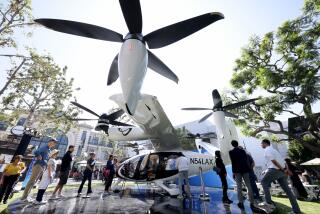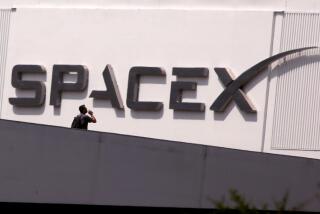Low-Cost Copter Builder Tops Sales of Big-Name Rivals : Aerospace: With FAA approval for its latest model, Torrance-based Robinson is expanding its manufacturing plant and adding 300 jobs.
Compared to giants like Lockheed, McDonnell Douglas and Northrop, the name Robinson Helicopter Co. may not ring a bell, but the privately owned company in Torrance ranks among the most successful aircraft companies in Southern California.
Robinson recently set plans for a major expansion of its plant at the Torrance Airport, following recent federal certification of its newest helicopter model, the R-44. It will add about 300 jobs next year, up from the current 420.
Frank Robinson left his comfortable job at a major aerospace company in 1973 to pursue a dream of building a low-cost commercial aircraft for a profit--an ambition that few other industrialists have fulfilled through the decades.
By 1988, Robinson was turning out the lowest-cost two-seat helicopter in the world, named the R-22, and the firm’s production volume surpassed the Big Four of the helicopter industry--Bell, Sikorsky, Boeing and McDonnell.
In the last three years, Robinson has accounted for 61% of U.S. helicopter production. Last year, the firm shipped 402 helicopters at an average price of $115,000. This year, its market share is up to 65%.
Now, Robinson is preparing for his next step, the four-seat R-44, a helicopter that he has been working on for eight years. The Federal Aviation Administration recently certified the craft, and Robinson is entering production with a backlog of 125 orders.
Robinson recently opened a new test and delivery center at the Torrance Airport, but had delayed for several years making a decision on where to build the R-44. The firm bought property in Santa Maria and considered moving much of its production there.
But after Torrance city officials made an attractive leasing offer for more land at the company’s current location, it abandoned the relocation plan and is preparing to add about 230,000 square feet of new factory space to build the R-44.
The company is financing the expansion project itself, although its banker, Union Bank, had proposed using revenue bonds. Lisa Rojas, a Union Bank loan officer, said the conservatively run company is “very strong” financially, adding, “I would say our comfort level is excellent with them.”
To be sure, Robinson’s revenues are small compared to other manufacturers in the industry because prices of the company’s helicopter are so cheap. Sales in 1991 were $50 million.
But while other aircraft producers are bracing for a protracted downturn in commercial orders, Robinson has seen an incipient upturn in business and is focusing on a slice of the market long abandoned by major U.S. aerospace firms.
Although Boeing continues to dominate the global market for big jetliners, American manufacturers have seen a steady erosion in their share of the market for small, low-cost aircraft.
Robinson has succeeded by defying some industry conventions. While other companies move toward producing fewer of the parts that go into their products, Robinson produces about 80% of non-custom parts for the R-22 and R-44.
“We have much better quality control and production control by producing them ourselves,” Robinson said.
The company’s busy plant produces the rotors, cockpit cabins, instrument panels, transmissions and landing struts for its helicopters, which are powered by off-the-shelf piston engines that the company buys from Textron Lycoming.
The new R-44 may enable the company to significantly expand its reach in the industry. The craft will sell for $235,000, but aims to compete with the five-seat Bell Jet Ranger, the helicopter of choice for executives.
The Jet Ranger, powered by a turbine engine, is priced at about $600,000. Robinson boasts that his R-44 will cruise at the same 130 miles per hour as the Jet Ranger.
Robinson hopes that the added size and speed of the R-44 will also open up new markets for police use, agricultural spraying, photography and patrol work--uses that the two-seat R-22 was too small to satisfy.
Developed at a cost of about $10 million, the R-44 is a major gamble for the company. The critical decision to remain in the Los Angeles Basin was made after a lot of serious soul-searching and after dozens of industrial recruiters from the Midwest and South tried to lure the company away.
But Robinson said Southern California’s large pool of trained workers, its huge base of aerospace suppliers, proximity to a major port and ideal weather for flying helicopters convinced him to stay.
“If we need a Class A welder, we can run an ad and have a number of applicants,” he said. “If we were in a small town, chances are we would still have to recruit the person here and pay them to relocate.”
Still, Robinson, like all major firms operating here, has serious problems with taxes, air quality regulations and what he calls the anti-business attitude of the state Legislature.
Although some experts dismiss complaints from manufacturers about cumbersome local government procedures to grant business permits, Robinson cites that issue as a major factor in the company’s decision not to move to Santa Maria.
Barbara Robinson, the company’s vice president for marketing and Frank’s wife, said Santa Maria officials dragged out discussions for various permits the firm needed.
Torrance officials, in contrast, granted the necessary approvals in just a few months, including making an attractive leasing offer for municipal land at the city airport, Barbara Robinson said.
By continuing its low-cost approach with the R-44, Robinson is hoping to duplicate its past success at finding sales in unexpected areas.
“We are going to develop a new market for executive and general utility helicopters,” Barbara Robinson said. “We think we will be expanding the use of helicopters in markets where it hasn’t been practical before.”
More to Read
Inside the business of entertainment
The Wide Shot brings you news, analysis and insights on everything from streaming wars to production — and what it all means for the future.
You may occasionally receive promotional content from the Los Angeles Times.











